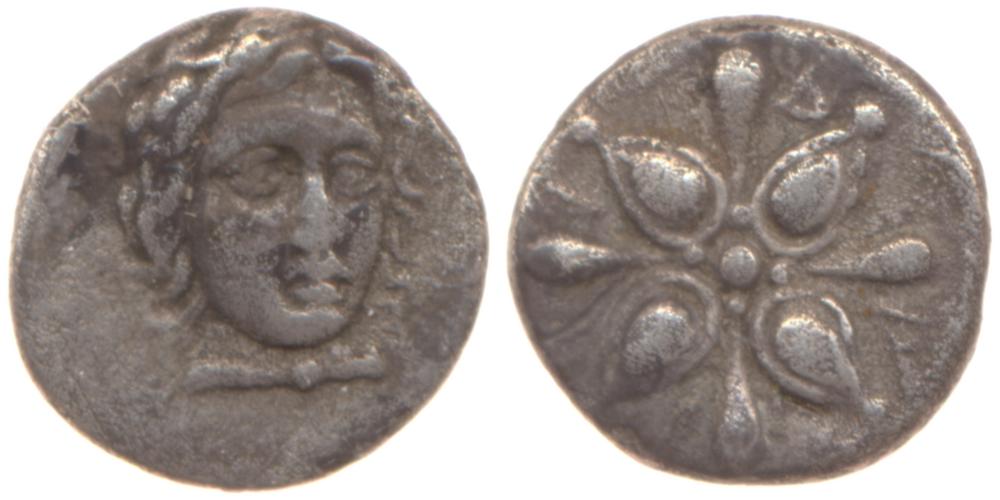AC 251b - Halicarnassus (Idrieus), silver, trihemiobols (351-343 BCE)
From SILVER
Bilgischer (talk | contribs) |
|||
| (2 intermediate revisions by one other user not shown) | |||
| Line 1: | Line 1: | ||
{{Die Study | {{Die Study | ||
| + | |Image=AC251b Halicarnassus.jpg | ||
| + | |Image reference=https://www.britishmuseum.org/collection/object/C_1883-0402-22 | ||
| + | |Obverse description=Head of Apollo three-quarter facing with wavy hair, chlamys fastened around neck. | ||
| + | |Reverse legend=Ι-Δ-Ρ-Ι | ||
| + | |Reverse legend language=Greek | ||
| + | |Reverse description=Rosette of Milesian type, eight rays emerging from central globule; Ι-Δ-Ρ-Ι inscribed between the rays. | ||
|Mint=Halicarnassus | |Mint=Halicarnassus | ||
|Ancient region=Caria | |Ancient region=Caria | ||
| − | |Authority= | + | |Authority=Idrieus (satrap of Caria, mid-4th century BC); Persian Empire |
|Date from=351 BCE | |Date from=351 BCE | ||
|Date to=343 BCE | |Date to=343 BCE | ||
| Line 11: | Line 17: | ||
|RQEM reference=RQMAC | |RQEM reference=RQMAC | ||
|RQEM reference number=251b | |RQEM reference number=251b | ||
| − | |Die study reference= | + | |Die study reference=Konuk 1998b, n° 145-164. |
|Coin series reference=RQEMAC, n° 251b | |Coin series reference=RQEMAC, n° 251b | ||
| + | |Coin series web reference=https://greekcoinage.org/iris/id/idrieus_caria_konuk_1998_2 | ||
|Number of obverse dies=9 | |Number of obverse dies=9 | ||
|Number of reverse dies=20 | |Number of reverse dies=20 | ||
|Number of coins=28 | |Number of coins=28 | ||
}} | }} | ||
Latest revision as of 11:42, 17 May 2023
351 BCE - 343 BCE Silver 192 kg
Description
| ObverseInscription or printing placed on the obverse.: | Head of Apollo three-quarter facing with wavy hair, chlamys fastened around neck. |
| ReverseInscription or printing placed on the reverse.: | Ι-Δ-Ρ-Ι (Greek).Rosette of Milesian type, eight rays emerging from central globule, Ι-Δ-Ρ-Ι inscribed between the rays. |
Mint and issuing power
| MintIdentifies the place of manufacture or issue of a numismatic object.: | Halicarnassus | Ancient regionAncient region.: | Caria | Modern countryModern country: Turkey | AuthorityIdentifies the issuing power. The authority can be "pretended" when the name or the portrait of X is on the coin but he/she was not the issuing power. It can also be "uncertain" when there is no mention of X on the coin but he/she was the issuing power according to the historical sources: | Idrieus (satrap of Caria, mid-4th century BC), Persian Empire |
Chronology
| FromIdentifies the initial date in a range assigned in a numismatic context. | 351 BCE | toIdentifies the final date in a range assigned in a numismatic context.. | 343 BCE | PeriodTime period of the numismatic object.: Classical 480-323 BC |
Physical description
| MetalThe physical material (usually metal) from which an object is made.: | Silver |
Median weightMedian of the weights of numismatic objects (in grams). in grams | 0.85 | DenominationTerm indicating the value of a numismatic object. Examples: tetradrachm, chalkous, denarius.: | trihemiobol |
StandardStandard.: |
Image

AC251b Halicarnassus.jpg [1]
References
| Die study referencePublication of the study: | Konuk 1998b1Konuk 1998b, n° 145-164. | ||
| Coin series referenceReference to coin series study: | RQEMAC2RQEMAC, n° 251b | ||
| Coin series web referenceCoin series web references: | |||
Obverse dies distribution
no distribution is available
Reverse dies distribution
no distribution is available
Quantification
| Number of obversesNumber of obverse dies. ᵖ (o) | 9 | Number of singletons (o1)The number of singleton coins. ᵖ | |
| Number of reverse diesNumber of reverse dies. (r) | 20 | Number of coinsNumber of coins. (n) | 28 |
| Coins per obverse dieNumber of coins per obverse die. (n/o) | 3.11 | Coins per reverse dieNumber of coins per reverse die. (n/r) | 1.4 |
| Reverse per obverse ratioRatio of obverse dies divided by reverse dies. (r/o) | 2.22 | Percentage of singletons (o1)number of coins (n) divided by the number of singletons (o1) ᵖ | % |
| Original number of dies (O) (Carter 1983 formula)The estimation of the number of coins according to Carter 1983 ᵖ | 11.28 | Coins struck if 20,000 as average productivity per dieCoins made if the average productivity for obverses (according to Carter) is 20,000. ᵖ | 225,600 |
| Original number of dies (O) (Esty 2011 formula)The estimation of the number of coins according to the singleton formula in Esty 2011 ᵖ (O) | 13.26 | Survival rate if 20,000 as average productivity per dieSurvival rate if average productivity is 20,000. ᵖ | 0.00012 |
| Coverage (o = % of O) (Esty 1984 formula)Esty 1984 - coverage (% of O) ᵖ (o = % of O) | % | Die productivity if survival rate 1/2,000Average productivity if survival rate is 1/2,000. ᵖ | 4,964.54 |
| Weight of silver (in kg) if 20,000 coins per die (O = Carter formula)Carter 1983 * Median weight * 20000 (*10 if gold or electrum) ᵖ | 192 kg <br /> 192 kg | Die productivity if survival rate 1/5,000Average productivity if survival rate is 1/5,000. ᵖ | 12,411.35 |
Remarks